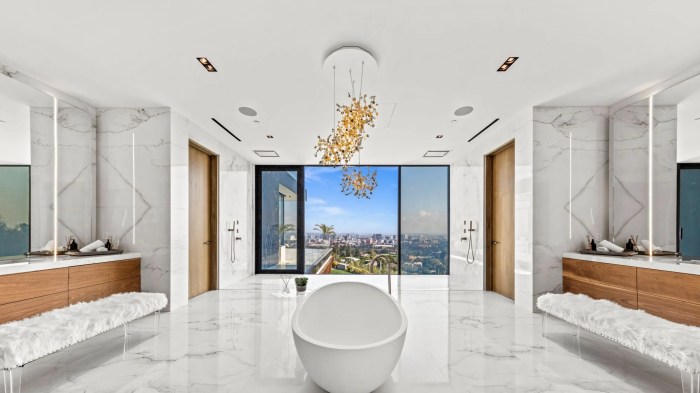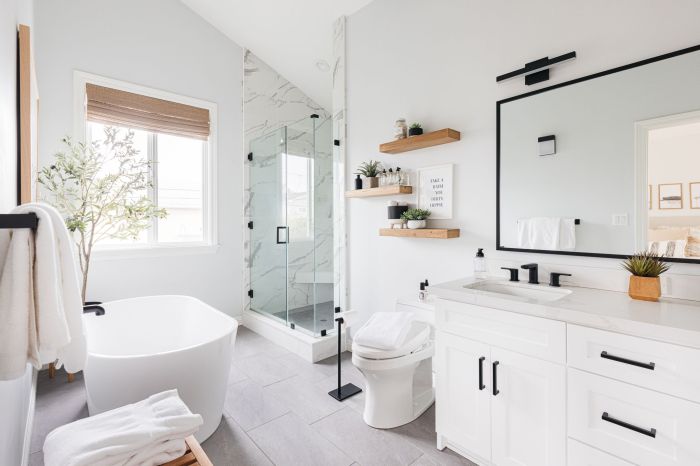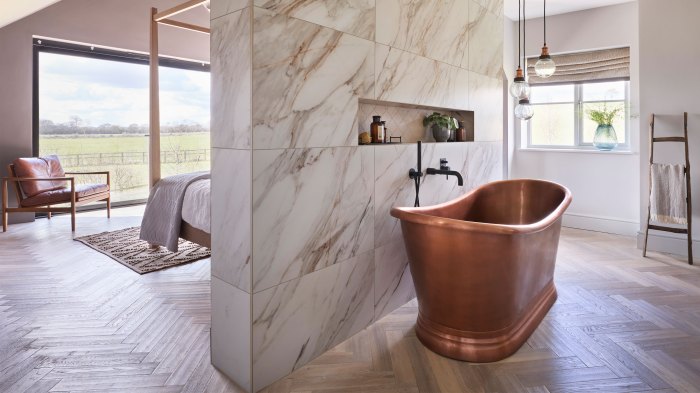Master Bathroom Layout & Space Planning

Master bedroom bathroom design ideas – Effective master bathroom design hinges on thoughtful layout and space planning. The optimal arrangement maximizes functionality, accessibility, and aesthetic appeal, considering the unique needs and preferences of the occupants. Careful consideration of traffic flow, fixture placement, and storage solutions are crucial for creating a truly comfortable and efficient space. This section will explore various layouts for master bathrooms of differing sizes, highlighting their respective advantages and disadvantages.
Master Bathroom Layouts for Varying Space
The ideal master bathroom layout is highly dependent on the available square footage. Smaller spaces necessitate a more compact and efficient design, while larger spaces offer greater flexibility for incorporating luxury features and enhancing accessibility. Three distinct layouts, representing small, medium, and large bathroom sizes, are presented below.
| Layout | Size (sq ft) | Dimensions (ft) | Fixture Placement | Advantages | Disadvantages |
|---|---|---|---|---|---|
| Small Bathroom | 40-60 | 6×8 to 8×10 | Single vanity, shower/tub combo, toilet. Fixtures are placed along one wall to maximize floor space. | Maximizes space utilization in compact areas; relatively inexpensive to build. | Limited storage; potential for cramped feel; may lack features like a separate shower and tub. |
| Medium Bathroom | 80-120 | 8×12 to 10×12 | Double vanity, separate shower and bathtub, toilet in a separate alcove, adequate counter space. A layout that separates the toilet and shower from the vanity area can improve privacy and flow. | Offers greater flexibility in fixture placement; allows for inclusion of additional features such as a linen closet; provides more comfortable space. | Requires more careful planning to ensure efficient use of space; can be more expensive to construct than smaller bathrooms. |
| Large Bathroom | 120+ | 10×15 or larger | Large double vanity, walk-in shower, freestanding bathtub, separate toilet area, ample storage space, potentially includes a bidet and other luxurious amenities. Zoning can create distinct areas for grooming, bathing, and relaxation. | Allows for luxurious features and personalized design; offers enhanced comfort and convenience; provides ample space for storage and movement. | Significantly higher construction costs; may require more maintenance; requires careful consideration of spatial relationships to avoid feeling empty or cavernous. |
Universally Designed Master Bathroom Layout
A universally designed master bathroom prioritizes accessibility and usability for individuals of all ages and abilities. This approach considers factors such as maneuverability, reach, and adaptability. Key features of a universally designed master bathroom include:
A universally designed bathroom emphasizes ease of use for all individuals, regardless of physical limitations. Designing with this approach in mind from the start ensures that the space remains functional and comfortable throughout the homeowner’s life.
| Feature | Description | Benefits |
|---|---|---|
| Roll-in shower | A shower with a curbless entry, allowing for easy wheelchair access. | Eliminates barriers to entry, improving mobility and safety for users with limited mobility. |
| Grab bars | Strategically placed bars near the toilet, shower, and bathtub for support. | Enhance safety and stability, reducing the risk of falls, particularly for elderly or individuals with balance issues. |
| Accessible toilet | A toilet positioned at a standard height with ample clearance on all sides. | Provides comfortable and easy access for wheelchair users and those with mobility limitations. |
| Adjustable shower head | A shower head that can be adjusted in height to accommodate users of varying heights. | Allows for greater comfort and convenience for users of all heights. |
| Clear floor space | Adequate space around fixtures to allow for wheelchair maneuvering and easy movement. | Ensures safe and comfortable navigation for wheelchair users and those with mobility devices. |
| Lever-style faucets | Faucets that are easy to operate with minimal hand strength or dexterity. | Improve accessibility for individuals with arthritis or other conditions affecting hand mobility. |
Master Bathroom Style & Design Themes

The selection of a design theme for a master bathroom significantly impacts the overall atmosphere and functionality of the space. Consideration should be given to personal preferences, lifestyle, and the architectural style of the home. The appropriate choice of theme can transform a simple bathroom into a luxurious retreat or a calming oasis. The following explores several distinct themes, highlighting their defining characteristics.
Master Bathroom Design Themes: A Comparative Overview
The choice of a master bathroom design theme is a crucial step in creating a space that reflects personal style and promotes well-being. Several distinct themes offer unique aesthetic and functional qualities. Below, we examine five prominent themes, detailing their characteristic features, color palettes, and materials.
- Modern Minimalist: This theme emphasizes clean lines, simple forms, and a neutral color palette. Think whites, grays, and blacks, often accented with a single bold color. Materials include sleek polished concrete, glass, and chrome fixtures. The focus is on functionality and a sense of spaciousness.
- Spa-Like Retreat: Designed for relaxation and rejuvenation, this theme incorporates natural materials like stone and wood, along with calming colors such as soft greens, blues, and earth tones. Features may include a soaking tub, rainfall showerhead, and dimmable lighting to create a tranquil ambiance. The texture of natural materials plays a key role.
- Rustic Farmhouse: This theme evokes a sense of warmth and comfort, using natural materials such as reclaimed wood, stone, and exposed brick. Color palettes are typically warm and inviting, featuring creams, browns, and muted greens. Features may include a freestanding clawfoot tub and vintage-inspired fixtures.
- Luxurious Victorian: Characterized by ornate details, rich colors, and luxurious materials, this theme often incorporates marble, intricate tilework, and antique-style fixtures. Color palettes are deep and opulent, featuring jewel tones like emerald green, ruby red, and sapphire blue. The overall impression is one of grandeur and elegance.
- Eclectic Bohemian: This theme blends various styles and textures to create a unique and personalized space. It often features a mix of patterns, colors, and materials, including natural fibers, vintage finds, and global influences. The color palette is typically vibrant and eclectic, with a focus on creating a space that feels both comfortable and expressive.
Natural and Artificial Lighting in Master Bathroom Design Themes
The interplay of natural and artificial lighting significantly impacts the mood and functionality of a master bathroom. Different design themes leverage these lighting sources to achieve specific aesthetic and practical goals.In a modern minimalist bathroom, natural light is maximized through large windows and skylights, complementing the clean and airy feel. Artificial lighting is typically recessed and strategically placed to avoid harsh shadows.
A spa-like retreat benefits from soft, diffused natural light, perhaps filtered through sheer curtains. Artificial lighting here would emphasize warm, low-level illumination, often using dimmable LED fixtures to create a relaxing atmosphere. Rustic farmhouse designs often incorporate natural light through strategically placed windows, enhancing the warmth of the space. Artificial lighting might include pendant lights or sconces with warm-toned bulbs.
Luxurious Victorian bathrooms might use natural light to highlight ornate details, while artificial lighting would be more elaborate, possibly including crystal chandeliers or ornate wall sconces. Finally, an eclectic bohemian bathroom might use a combination of natural and artificial light sources to create a layered and dynamic lighting scheme, reflecting the diverse elements of the design.
Example Master Bathroom Design: Spa-Like Retreat
This design prioritizes relaxation and rejuvenation. The color palette is based on calming earth tones, using various shades of beige, taupe, and muted green. The flooring is composed of large, polished porcelain tiles in a light beige color, mimicking the look of natural stone. The walls are clad in large, smooth, light-green tiles, providing a clean and calming backdrop.
A freestanding soaking tub made of natural stone sits centrally, serving as a focal point. A rainfall showerhead is installed, delivering a spa-like showering experience. Natural light streams in through a large window, diffused by sheer linen curtains. Artificial lighting consists of dimmable LED recessed lights and a single pendant light above the tub, providing soft, warm illumination.
The vanity is made of natural wood, featuring sleek chrome fixtures. The overall effect is a serene and tranquil space that promotes relaxation and well-being. This choice reflects a commitment to creating a space that fosters calmness and reduces stress, aligning with the principles of biophilic design, which incorporates natural elements to improve well-being.
Master Bathroom Lighting & Decor

The master bathroom, a sanctuary of relaxation and rejuvenation, demands careful consideration of both functional and aesthetic elements. Lighting plays a crucial role in setting the mood and ensuring visibility for everyday tasks, while decor enhances the overall ambiance and reflects personal style. A well-designed lighting plan, coupled with strategic use of mirrors and artwork, transforms this space into a true haven.
Master Bathroom Lighting Plan
Effective bathroom lighting requires a layered approach, combining ambient, task, and accent lighting to create a versatile and comfortable environment. Ambient lighting provides overall illumination, typically achieved through recessed ceiling lights or a stylish chandelier. These fixtures should offer a soft, even light distribution, minimizing harsh shadows. Task lighting, on the other hand, focuses on specific areas, such as the vanity and shower.
Here, we need bright, focused light to facilitate activities like shaving, applying makeup, or showering safely. Vanity lights, either integrated into the mirror or mounted on either side, are ideal for this purpose. Finally, accent lighting highlights architectural features or artwork, adding depth and visual interest. This could involve strategically placed sconces or LED strip lighting to create a warm glow.
For example, a recessed light above the shower, combined with vanity lights with a color temperature of 4000K (cool white), and accent lighting in the form of warm white (2700K) LED strip lights under the vanity cabinet, creates a balanced and functional lighting scheme. The choice of light sources should consider energy efficiency and longevity, with LED lights being a preferable option due to their low energy consumption and long lifespan.
Mirror and Artwork Selection
Mirrors are essential in a bathroom, serving both practical and aesthetic purposes. A large, well-placed mirror can visually expand the space and enhance natural light. Consider a framed mirror to add a touch of elegance or a minimalist, frameless mirror for a contemporary feel. Beyond the primary mirror above the vanity, smaller mirrors can be strategically incorporated near the shower or bathtub to enhance convenience and add visual interest.
The size and style of the mirror should complement the overall design scheme. Artwork can elevate the bathroom’s aesthetic appeal, transforming it from a purely functional space into a personal sanctuary. Choose pieces that resonate with your style and create a calming atmosphere. Watercolor paintings, nature photography, or abstract art can all work well, depending on the overall design theme.
The artwork should be framed appropriately and protected from moisture, considering the bathroom’s humid environment. For instance, a large, framed botanical print above the bathtub and a smaller, framed abstract piece near the shower could add visual interest without overwhelming the space. The selection of artwork and mirrors should take into consideration the overall color palette and textures to create a cohesive design.
Master Bathroom Mood Board Creation, Master bedroom bathroom design ideas
A mood board serves as a visual representation of the desired aesthetic for the master bathroom. This tool allows for the exploration of color palettes, textures, and design elements before committing to any decisions. Start by selecting a dominant color palette. For example, a calming palette might include shades of blue, green, and gray, while a more luxurious feel could be achieved with gold, beige, and white.
Next, consider the textures. Natural materials like stone, wood, and marble can create a sense of warmth and sophistication. Alternatively, sleek, modern materials like glass and polished chrome can create a contemporary aesthetic. Incorporate images of tiles, flooring, fixtures, and other design elements that align with the chosen color palette and textures. Include examples of lighting fixtures, mirrors, and artwork that fit the overall vision.
So, you’re thinking about a rad master bedroom bathroom, eh? Making it feel spacious is key, right? Even the ceiling matters! Check out these awesome ideas for ceiling design for small bedroom to get some inspo for maximizing your space. That’ll help you create a killer master bathroom that’s not cramped. Then, you can focus on those fancy tiles and a sweet shower!
Finally, add swatches of fabrics, such as towels or bath mats, to further refine the color and texture choices. The mood board should capture the overall atmosphere you aim to create – whether it’s serene and spa-like or vibrant and modern. For instance, a mood board for a spa-inspired bathroom might include images of natural stone tiles, bamboo accents, calming blue hues, and a large, framed botanical print.
In contrast, a mood board for a modern bathroom might feature sleek white tiles, chrome fixtures, and minimalist artwork.
Master Bathroom Storage & Organization: Master Bedroom Bathroom Design Ideas
Effective storage is paramount in a master bathroom, transforming a chaotic space into a haven of serenity. The principles of ergonomics and efficient space utilization are key, ensuring ease of access and a visually appealing environment. Careful consideration of storage solutions tailored to individual needs and the bathroom’s unique layout is crucial for achieving optimal functionality and aesthetic harmony.
Effective Master Bathroom Storage Solutions
The strategic placement of storage solutions significantly impacts the overall usability and visual appeal of a master bathroom. The following table categorizes various storage options based on location and type, highlighting their respective strengths and weaknesses.
| Location | Type | Benefits | Considerations |
|---|---|---|---|
| Under-Sink | Pull-out drawers | Maximizes under-sink space, provides easy access to items. | Requires careful measurement to ensure proper fit. May not be suitable for all sink types. |
| Under-Sink | Adjustable shelving | Adaptable to various item sizes, cost-effective solution. | Items may be less visible than in drawers. |
| Wall-Mounted | Medicine cabinets | Classic solution, offers both storage and a mirror. | Limited storage capacity compared to other options. |
| Wall-Mounted | Floating shelves | Stylish and space-saving, ideal for displaying toiletries. | Limited storage capacity, requires sturdy wall mounting. |
| Corner | Corner cabinets | Utilizes often-wasted corner space. | Can be difficult to access items in deep corners. |
| Above Toilet | Wall-mounted cabinets | Utilizes vertical space above the toilet. | May require custom sizing to fit the space perfectly. |
Benefits of Built-in Storage in a Master Bathroom
Built-in storage offers unparalleled advantages in master bathroom design. Custom-designed units seamlessly integrate with the bathroom’s architecture, maximizing space utilization and creating a cohesive, uncluttered aesthetic. Built-in solutions can be tailored to accommodate specific needs, such as tall linen cabinets or recessed shelving for towels and toiletries. This approach eliminates the need for bulky, freestanding units, contributing to a more spacious and elegant feel.
Furthermore, built-in storage often enhances the resale value of a home, as it represents a high-quality, permanent fixture.
Maximizing Space and Organization in a Small Master Bathroom
In smaller bathrooms, strategic storage solutions are critical. Utilizing vertical space with tall, narrow cabinets is key. Mirrors can visually expand the space, while light-colored cabinetry can create an illusion of openness. Multi-functional furniture, such as a vanity with integrated storage, can efficiently combine storage and utility. Employing clear containers and labels helps maintain order and visually declutters the space.
Regular purging of unused items prevents accumulation and maintains efficient storage. Consider using space-saving organizers within drawers and cabinets to further maximize capacity. For example, stackable drawers or vertical dividers can create order within limited space. The principle of “a place for everything, and everything in its place” is crucial for small bathroom organization.
Helpful Answers
What is the best flooring for a master bathroom?
The best flooring depends on your style and budget. Porcelain tile is durable and water-resistant, while natural stone offers luxury but requires more maintenance. Luxury vinyl plank (LVP) provides a stylish, waterproof alternative.
How much should I budget for a master bathroom remodel?
Bathroom remodel costs vary widely based on size, materials, and complexity. Expect to spend anywhere from a few thousand to tens of thousands of dollars.
How can I make a small master bathroom feel larger?
Use light colors, maximize natural light, choose a floating vanity, and install a large mirror to create the illusion of more space. Minimize clutter and choose streamlined fixtures.
What are some eco-friendly options for a master bathroom?
Consider low-flow showerheads and faucets, recycled materials (like reclaimed wood), and water-saving toilets. Choose sustainably sourced materials like bamboo or sustainably harvested wood.
